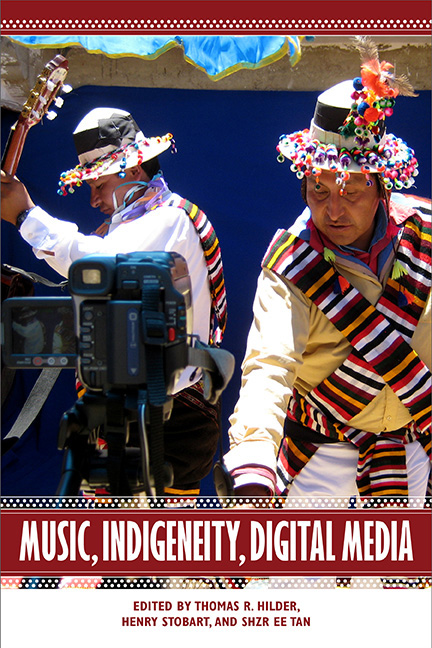Book contents
- Frontmatter
- Dedication
- Contents
- List of Illustrations
- Acknowledgments
- Music, Indigeneity, Digital Media: An Introduction
- 1 Taiwan's Aboriginal Music on the Internet
- 2 Recording Technology, Traditioning, and Urban American Indian Powwow Performance
- 3 YouTubing the “Other”: Lima's Upper Classes and Andean Imaginaries
- 4 An Interview with Russell Wallace
- 5 Mixing It Up: A Comparative Approach to Sámi Audio Production
- 6 Creative Pragmatism: Competency and Aesthetics in Bolivian Indigenous Music Video (VCD) Production
- 7 Keepsakes and Surrogates: Hijacking Music Technology at Wadeye (Northwest Australia)
- 8 The Politics of Virtuality: Sámi Cultural Simulation through Digital Musical Media
- Selected Bibliography
- List of Contributors
- Index
2 - Recording Technology, Traditioning, and Urban American Indian Powwow Performance
Published online by Cambridge University Press: 26 April 2018
- Frontmatter
- Dedication
- Contents
- List of Illustrations
- Acknowledgments
- Music, Indigeneity, Digital Media: An Introduction
- 1 Taiwan's Aboriginal Music on the Internet
- 2 Recording Technology, Traditioning, and Urban American Indian Powwow Performance
- 3 YouTubing the “Other”: Lima's Upper Classes and Andean Imaginaries
- 4 An Interview with Russell Wallace
- 5 Mixing It Up: A Comparative Approach to Sámi Audio Production
- 6 Creative Pragmatism: Competency and Aesthetics in Bolivian Indigenous Music Video (VCD) Production
- 7 Keepsakes and Surrogates: Hijacking Music Technology at Wadeye (Northwest Australia)
- 8 The Politics of Virtuality: Sámi Cultural Simulation through Digital Musical Media
- Selected Bibliography
- List of Contributors
- Index
Summary
Introduction
The activity of music has always played a crucial role in my life as a teacher, scholar, musician, and human being. While changes in the technologies used to listen to music are often phrased in terms of “replacing” what came before for the sake of convenience, superior sound quality, or some other benefit, I find that my music collection at home still contains fairly equal parts vinyl, cassette, compact disc, and mp3. As a professional musician and scholar of American Indian musics, I have found that no single recording medium can serve all my needs. This is especially visible and audible when I look and listen to my collection of powwow music, in which homemade and commercially produced cassettes outnumber other formats.
This paper will reflect upon my lived experiences using both analog and digital recording technologies as a means to learn, archive, and disseminate powwow music. In this way the present work is broadly inspired by my correspondence with Professor David McAllester, in in which Professor McAllester once remarked that “much of the future of American Indian ethnomusicology will be ‘homework’ rather than ‘fieldwork’ and in the hands of Native musicologists.” As an urban Native (ethno)musicologist of Mescalero Apache, Irish, German, and Chicano descent, my homework for this chapter begins by situating myself more specifically in relation to relevant studies in ethnomusicology and American Indian Studies. I then discuss my formative period utilizing analog technology to learn Northern Plains powwow singing under the tutelage of Dr. Bernard Hoehner (Lakhǒta) as an undergraduate student at San Francisco State University (SFSU) in the mid-1990s. I then turn to my experiences utilizing analog and digital technologies while co-leading the Sweetwater Singers and teaching American Indian music at universities in the San Francisco Bay Area from the early 2000s to the present.
In the context of this volume, the practices and experiences discussed in this chapter address “the ways in which Indigenous people have utilized digital technologies to revive … and transmit musical traditions in complex articulations of Indigeneity.”
- Type
- Chapter
- Information
- Music, Indigeneity, Digital Media , pp. 53 - 73Publisher: Boydell & BrewerPrint publication year: 2017



